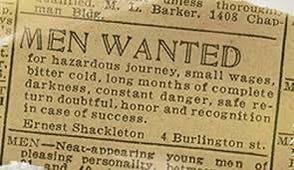Manipulation and Persuasion
False Modesty, Self-Deprecation
Myths and Hoaxes
CLARISSA took to her work with wholehearted determination, though she seemed to have no confidence in her abilities at all. Whenever I gave her a job to do, she would begin stroking her muff and looking at the floor. She’d tell me that it sounded much too hard for her, but that she knew how much I was counting on her, and so she’d try, so long as I’d agree not to be angry with her if she couldn’t do the job the way it should be done. …
She actually made an asset of her timidity, especially when she was recruiting someone for a job. One afternoon I watched her, clipboard in hand, walk up to a group of kids in the hall and say, her eyes wide, her voice quavering, “I need six stagehands, but you don’t want to be stagehands, do you? Probably not. I don’t blame you. I do need six stagehands, though, and I need them right away. I don’t know why anybody would want to do it, really. There’s no glory to the job. You’ll have to work long hours, and you’ll get dirty and sweaty. While the other kids are taking bows, you’ll be backstage, out of sight. You’ll stand there with the applause ringing in your ears and a lump in your throat, thumping one another on the back, and the only satisfaction you’ll get is knowing that you’ve done something fine, really fine.” She brought her muff up to her face and rubbed her eyes with it. Then she swallowed hard, stood up straight and said, “It’s just not worth the trouble, I guess.” She started to walk away, but the boys and girls quickly surrounded her, climbing over one another trying to sign up.Little Follies, “The Girl with the White Fur Muff”
Manipulation or Emotional Manipulation is the use of devious means to exploit, control, or otherwise influence others to one’s advantage. In the extreme it is the purvey of tricksters, swindlers, and impostors who disrespect moral principles, deceive and take advantage of others’ frailty and gullibility. At the very least, manipulation is forced influence used to gain control, benefits, and/or privileges at the expense of the others.
Manipulation differs from general influence and persuasion. Persuasion is the ability to move a person or persons to a desired action, usually within the context of a specific goal. Influence and persuasion are neither positive nor negative. Influence is generally perceived to be harmless as it respects the right of the influenced to accept or reject it, and is not unduly coercive.Characteristics of manipulators
Studies of the predictors of emotional manipulation indicate that the mechanisms behind emotional manipulation differ as a function of gender:
“For males, higher levels of emotional intelligence, social information processing, indirect aggression, and self-serving cognitive distortions significantly predicted emotional manipulation.”
“For females, being younger, higher levels of emotional intelligence, indirect aggression, primary psychopathic traits, and lower levels of social awareness significantly predicted emotional manipulation. However for females, emotional intelligence acted as a suppressor.”Characteristics of manipulation
Common means of manipulation can be categorized as:
Positive reinforcement: includes praise, superficial charm, superficial sympathy (crocodile tears), excessive apologizing, money, approval, gifts, attention, facial expressions such as a forced laugh or smile, and public recognition.
Negative reinforcement: includes nagging, yelling, the silent treatment, intimidation, threats, swearing, emotional blackmail, guilt trips, sulking, crying, and playing the victim, using verbal abuse, explosive anger, or other intimidating behavior to establish dominance or superiority; even one incident of such behavior can condition or train victims to avoid upsetting, confronting or contradicting the manipulator.Manipulators exploit the following vulnerabilities:
Naïveté or immatur[ity] People who find it too hard to accept the idea that some people are cunning, devious and ruthless or are “in denial” if they are being taken advantage of
Over-conscientiousness People who are too willing to give another the benefit of the doubt and see their side of things.
Low self-esteem People who struggle with self-doubting, lacking in confidence and assertiveness, and who are likely to go on the defensive too easily.
Over-intellectualization People who try too hard to understand and believe that others have some understandable reason to be manipulative.
Emotional dependency People who have a submissive or dependent personality. The more emotionally dependent a person is, the more vulnerable they are to being exploited and manipulated.
Greed People who are greedy and dishonest may be easily enticed to act in an immoral way.
Shouldn’t Vanity be in the list of vulnerabilities? Isn’t vanity the vulnerability that Clarissa exploited to recruit stagehands? (Was she, perhaps, “inspired” by Ernest Shackleton’s famous advertisement recruiting men for his “Imperial Trans Antarctic Expedition”?) Hmmm. Maybe vanity is included in low self-esteem.
BTW: The famous Shackleton ad may be a myth—possibly even a hoax. See “Shackleton Probably Never Took Out an Ad Seeking Men for a Hazardous Journey” by Colin Schultz in Smithsonian Magazine. Of course, being a myth or hoax would not have eliminated Shackleton’s ad as a source of “inspiration,” since much of what we fallible humans think and do is “inspired” by myths and hoaxes.
See also: Self-Deprecation TG 39
[more to come on Wednesday, November 24, 2021]
Have you missed an episode or two or several?
You can begin reading at the beginning or you can catch up by visiting the archive or consulting the index to the Topical Guide.
You can listen to the episodes on the Personal History podcast. Begin at the beginning or scroll through the episodes to find what you’ve missed.
At Apple Books you can download free eBooks of “My Mother Takes a Tumble,” “Do Clams Bite?,” “Life on the Bolotomy,” “The Static of the Spheres,” and “The Fox and the Clam,” the first five novellas in Little Follies.
You’ll find an overview of the entire work in An Introduction to The Personal History, Adventures, Experiences & Observations of Peter Leroy. It’s a pdf document.



